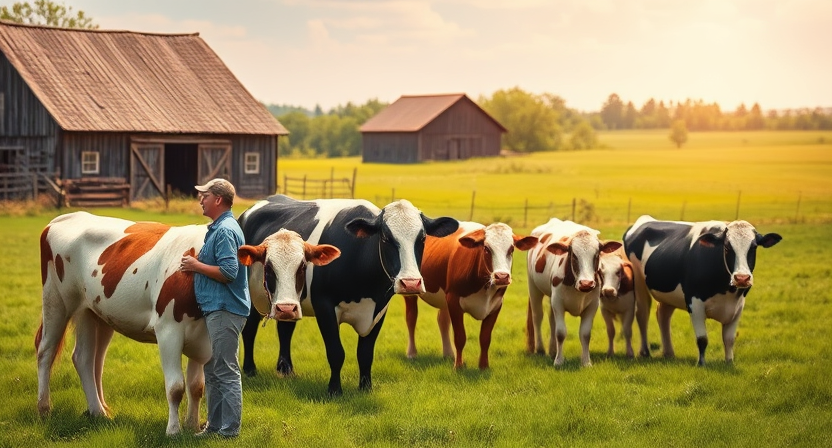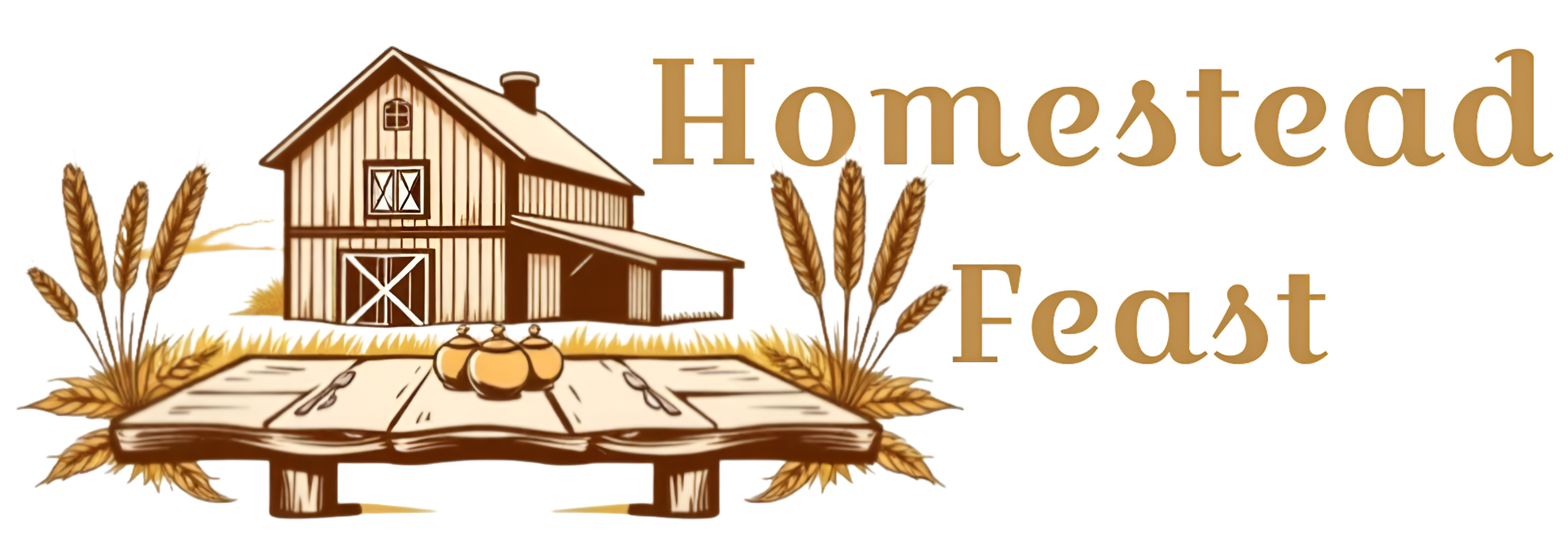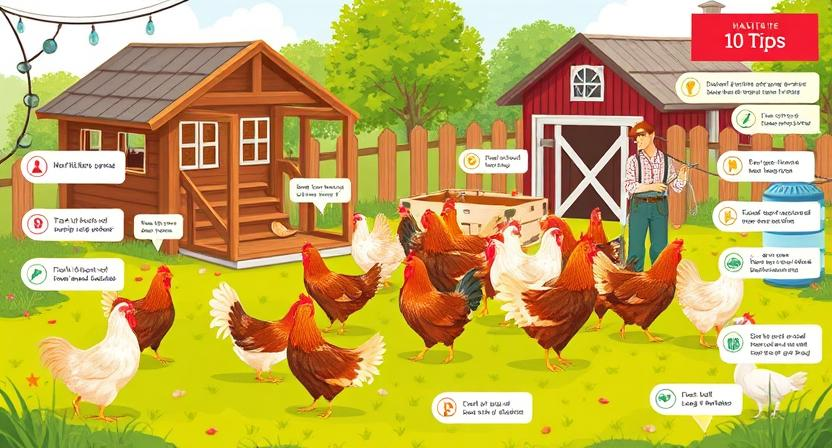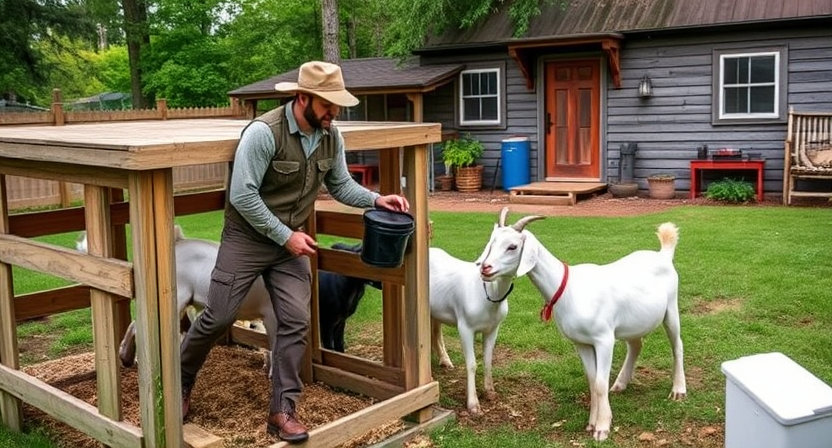Choosing the Best Breed of Cows for Small Homesteads

Characteristics of Ideal Breeds for Small Homesteads

When considering ideal breeds for small homesteads, it’s important to prioritize adaptability and versatility. Look for breeds that are known for their resilience to various climates and ability to thrive in different environments. Additionally, breeds that have dual-purpose capabilities, such as providing both milk and meat, can be advantageous for small homestead operations.
Another key characteristic to look for in ideal breeds for small homesteads is their temperament. Opt for breeds that are known to be docile, easy to handle, and well-suited for small-scale farming settings. A breed with a gentle nature can make daily tasks more manageable and enjoyable, especially for those new to homesteading.
• Adaptability to various climates
• Versatility in different environments
• Dual-purpose capabilities (milk and meat production)
• Docile temperament
• Easy to handle
• Well-suited for small-scale farming settings
Common Breeds for Small Homesteads

When it comes to common breeds for small homesteads, the Nigerian Dwarf goat is a popular choice. Known for their small size, friendly temperament, and high milk production, Nigerian Dwarf goats are ideal for small-scale milk production. Additionally, their adaptable nature makes them suitable for various climates and they do not require a large amount of space to thrive.
Another common breed for small homesteads is the Rhode Island Red chicken. These chickens are known for their dual-purpose characteristics, providing both meat and eggs. They are hardy birds that adapt well to different environments and are relatively low maintenance, making them a practical choice for small homesteads looking to raise chickens for both meat and eggs.
• Nigerian Dwarf goats are popular for small homesteads due to their small size and high milk production
• They have a friendly temperament and are adaptable to various climates
• Rhode Island Red chickens are common for small homesteads as they provide both meat and eggs
• These chickens are hardy, adapt well to different environments, and require low maintenance
Factors to Consider When Choosing a Breed

When choosing a breed for your small homestead, there are several important factors to consider. First and foremost, evaluate the purpose of your livestock – whether it is for dairy production, meat production, or both. Different breeds excel in specific areas, so matching the breed to your intended use is crucial for success on your homestead. Additionally, consider the climate and environment of your region. Some breeds are more adaptable to extreme temperatures or varying weather conditions, so choose a breed that will thrive in your specific location.
– Consider the space available on your homestead, as some breeds require more room to roam and graze than others
– Take into account the temperament of the breed, especially if you have children or other animals on your homestead
– Research the health and maintenance requirements of each breed, as some may need more frequent grooming or veterinary care than others
– Look into the availability of resources for your chosen breed in your area, such as feed options or local veterinarians who are familiar with that specific type of livestock.
Dairy Breeds vs. Beef Breeds

When considering whether to raise dairy breeds or beef breeds on your small homestead, it’s essential to evaluate your specific goals and resources. Dairy breeds, such as Holsteins and Jerseys, are primarily bred for milk production and are well-suited for those looking to produce their dairy products. These breeds require consistent milking schedules and specialized care to maintain milk production levels.
On the other hand, beef breeds, like Angus and Herefords, are raised for their meat production. These breeds tend to grow larger and require more space and feed compared to dairy breeds. Beef breeds may be more suitable for homesteaders looking to produce their meat for consumption or sale. It’s important to consider the time and resources needed to raise either dairy or beef breeds successfully.
• Dairy breeds, such as Holsteins and Jerseys, are primarily bred for milk production
• Dairy breeds require consistent milking schedules and specialized care to maintain milk production levels
• Beef breeds, like Angus and Herefords, are raised for their meat production
• Beef breeds tend to grow larger and require more space and feed compared to dairy breeds
• Beef breeds may be more suitable for homesteaders looking to produce their meat for consumption or sale
When deciding between dairy or beef breeds, it’s crucial to consider your goals as a homesteader. If you’re interested in producing your dairy products like cheese or yogurt, then dairy breeds may be the way to go. However, if you’re looking to raise animals primarily for meat production, beef breeds might be a better fit. Additionally, think about the amount of time and resources you have available to dedicate to raising either type of breed.
Ultimately, both dairy and beef breeds can be valuable additions to a small homestead operation. It’s essential to carefully weigh the pros and cons of each type of breed based on your specific needs before making a decision. By considering factors such as space requirements, feeding costs, and time commitments upfront, you can set yourself up for success when raising either dairy or beef cattle on your homestead.
Climate Adaptability of Different Breeds

Different breeds of livestock exhibit varying levels of climate adaptability based on their genetic makeup and evolutionary history. Some breeds, such as the Icelandic sheep, are well-suited to harsh and cold environments due to their thick woolly coats and ability to forage for food even in challenging conditions. On the other hand, breeds like the Nubian goat thrive in warmer climates with their high heat tolerance and efficient water consumption.
It is important for small homestead owners to consider the climate of their region when selecting breeds to ensure the animals can thrive in their environment. By choosing breeds that are well-adapted to the local climate, homesteaders can minimize the risk of health issues and optimize the overall well-being of their livestock. Conducting thorough research on the climate adaptability of different breeds can ultimately lead to a more successful and sustainable homestead operation.
• Some breeds, like the Icelandic sheep, are well-suited to harsh and cold environments
• Other breeds, such as the Nubian goat, thrive in warmer climates
• Selecting breeds adapted to the local climate can minimize health issues for livestock
• Thorough research on breed adaptability can lead to a more successful homestead operation
Size and Space Requirements for Various Breeds

Different breeds of livestock have varying size and space requirements that small homestead owners must consider when deciding which animals to raise. For example, dairy cattle like Holsteins and Jerseys generally require more space compared to breeds like Dexter or Miniature Herefords. It’s important to ensure that there is enough grazing land or pasture area to accommodate the needs of the livestock without overcrowding.
Similarly, when it comes to raising chickens, breeds such as Rhode Island Reds or Australorps may require more space compared to bantam breeds like Silkies or Sebrights. Providing adequate space for chickens to roam and forage not only ensures their well-being but also helps in preventing overcrowding-related issues such as aggression or disease. Proper planning and consideration of size and space requirements are crucial in creating a sustainable and healthy environment for livestock on small homesteads.
• Dairy cattle like Holsteins and Jerseys generally require more space
• Breeds like Dexter or Miniature Herefords need less space
• Adequate grazing land or pasture area is important for livestock without overcrowding
• Rhode Island Reds or Australorps may require more space compared to bantam breeds like Silkies or Sebrights
• Providing adequate space for chickens to roam and forage ensures their well-being
• Proper planning and consideration of size and space requirements are crucial in creating a sustainable environment for livestock on small homesteads
Temperament of Different Breeds

Understanding the temperament of different breeds is crucial when selecting animals for a small homestead. Some breeds are known for being docile and easy to handle, making them ideal for beginners or those with less experience. On the other hand, certain breeds may exhibit more independent or skittish behavior, requiring a knowledgeable hand to manage effectively. It’s important to consider your own comfort level and expertise when choosing breeds based on temperament.
Additionally, the temperament of breeds can also impact their interactions with other animals on the homestead. Some breeds may be more sociable and adaptable, making them good companions for other livestock. Conversely, breeds with aggressive tendencies may need to be housed separately or managed carefully to prevent conflicts. By taking the temperament of different breeds into account, homestead owners can create a harmonious environment that promotes the well-being of all their animals.
• Certain breeds are known for being docile and easy to handle
• Some breeds may exhibit more independent or skittish behavior
• Consider your own comfort level and expertise when choosing breeds based on temperament
• The temperament of breeds can impact their interactions with other animals on the homestead
• Some breeds may be more sociable and adaptable, making them good companions for other livestock
• Breeds with aggressive tendencies may need to be housed separately or managed carefully
Feed and Nutrition Requirements for Different Breeds

Different breeds of animals have varying feed and nutrition requirements based on their size, activity level, and purpose. It is crucial for small homestead owners to understand the specific dietary needs of their chosen breed to ensure optimal health and productivity. For example, dairy breeds may require higher levels of protein and certain minerals to support milk production, while meat breeds may need a diet rich in energy-dense feed to support growth and muscle development.
It is recommended to consult with a veterinarian or livestock nutritionist to develop a feeding program tailored to the specific needs of the breed. Proper nutrition plays a significant role in the overall health and performance of animals on a small homestead, emphasizing the importance of providing a balanced diet that meets all essential nutrient requirements. Additionally, considering factors such as access to pasture, forage quality, and availability of supplemental feed can also impact the nutritional requirements of different breeds.
• Dairy breeds may require higher levels of protein and certain minerals for milk production
• Meat breeds may need a diet rich in energy-dense feed for growth and muscle development
• Consult with a veterinarian or livestock nutritionist to develop a feeding program tailored to specific breed needs
• Proper nutrition is crucial for overall health and performance of animals on small homesteads
• Balanced diet meeting essential nutrient requirements is important
• Factors like access to pasture, forage quality, and availability of supplemental feed can impact nutritional requirements
Reproduction and Breeding Considerations

When considering reproduction and breeding on a small homestead, it is essential to understand the specific genetic traits and characteristics of the breed you are working with. Selecting breeding stock with desirable traits such as good health, temperament, and productivity can contribute to the overall success of your breeding program. Thoughtful breeding practices can help maintain the breed’s integrity and improve its overall quality over generations.
It’s important to have a clear breeding plan in place, including goals for genetic improvement, breeding methods, and proper record-keeping to track lineage and genetic traits. Understanding breeding cycles, mating techniques, and potential health considerations is crucial for successful reproduction on a small homestead. By staying informed about best breeding practices and seeking guidance from experts when needed, small homestead owners can ensure the long-term health and productivity of their livestock.
• Select breeding stock with desirable traits such as good health, temperament, and productivity
• Thoughtful breeding practices can maintain breed integrity and improve quality over generations
• Have a clear breeding plan in place with goals for genetic improvement and proper record-keeping
• Understand breeding cycles, mating techniques, and potential health considerations
• Stay informed about best breeding practices and seek guidance from experts when needed
Health and Disease Susceptibility of Different Breeds

When considering different breeds for your small homestead, it is important to take into account their health and disease susceptibility. Some breeds may be more prone to certain illnesses or conditions compared to others. It’s crucial to research and understand the common health issues that each breed may face to ensure you can provide the necessary care and attention.
Additionally, factors such as the environment, climate, and management practices on your homestead can also play a role in the overall health and disease susceptibility of the animals. By selecting breeds that are well-suited to your specific conditions and implementing proper preventive measures, you can help minimize the risk of potential health problems and ensure the well-being of your livestock.
• When considering different breeds for your small homestead, it is important to take into account their health and disease susceptibility.
• Some breeds may be more prone to certain illnesses or conditions compared to others.
• Researching common health issues that each breed may face is crucial for providing necessary care and attention.
• Factors such as environment, climate, and management practices on your homestead can also affect the overall health and disease susceptibility of the animals.
• Selecting breeds well-suited to specific conditions and implementing proper preventive measures can help minimize the risk of potential health problems.
Milk Production Potential of Various Breeds

When considering the milk production potential of various breeds for your small homestead, it is essential to take into account factors such as the breed’s genetics, feeding regimen, and overall health. Some dairy breeds, like the Holstein, are known for their high milk production, yielding large quantities of milk per lactation cycle. On the other hand, smaller breeds such as the Nigerian Dwarf may not produce as much milk in volume but are prized for the high butterfat content in their milk, making it ideal for cheese and butter production.
Additionally, breeds like the Jersey and Guernsey are valued for their rich and creamy milk, making them popular choices for small homesteads looking to produce high-quality dairy products. Understanding the milk production potential of different breeds can help you make an informed decision based on your specific needs and goals for your homestead.
• Holstein cows are known for their high milk production
• Nigerian Dwarf goats may not produce as much milk in volume but have high butterfat content
• Jersey and Guernsey breeds are valued for their rich and creamy milk
• Consider genetics, feeding regimen, and overall health when choosing a breed for your homestead
Meat Quality of Different Breeds

When considering the meat quality of different breeds for small homesteads, it is important to evaluate factors such as marbling, tenderness, and flavor profile. Some breeds, like Angus and Hereford cattle, are known for producing well-marbled beef with excellent tenderness and flavor. On the other hand, certain heritage breeds such as Red Wattle pigs are prized for their rich and succulent meat that is favored by many discerning palates.
Additionally, it is crucial to consider the growth rate and feed conversion efficiency of different breeds when assessing meat quality. Breeds like the Duroc pig and the Limousin cattle are known for their ability to efficiently convert feed into lean muscle mass, resulting in flavorful and well-textured meat. By understanding the unique characteristics of each breed, homesteaders can select animals that will not only thrive on their small farm but also provide high-quality meat for their tables.
• Angus and Hereford cattle are known for producing well-marbled beef with excellent tenderness and flavor
• Red Wattle pigs are prized for their rich and succulent meat
• Duroc pigs and Limousin cattle efficiently convert feed into lean muscle mass, resulting in flavorful meat
When choosing breeds for a small homestead, it is also important to consider factors such as the animal’s temperament, adaptability to local climate conditions, and overall health. Some breeds may be more docile and easier to handle, making them ideal for beginners or families with children. Others may be better suited to harsh climates or have natural resistance to common diseases found on small farms.
Furthermore, homesteaders should take into account the space requirements of each breed when planning their livestock operations. Some animals may require more pastureland or housing facilities than others, so it is essential to choose breeds that can comfortably thrive within the available resources on the homestead.
• Consider animal temperament when selecting breeds
• Take into account adaptability to local climate conditions
• Evaluate overall health characteristics of different breeds
• Factor in space requirements for each breed on the homestead
In conclusion, when evaluating the meat quality of different breeds for small homesteads, there are several key factors to consider beyond just taste and texture. By examining traits such as growth rate, feed conversion efficiency, temperament, adaptability, health characteristics, and space requirements; homesteaders can make informed decisions about which breeds will best suit their needs while providing high-quality meat for their families. With careful consideration and research, small-scale farmers can raise healthy animals that not only thrive on their land but also produce delicious meats for consumption.
Longevity and Lifespan of Different Breeds

When considering the longevity and lifespan of different breeds for your small homestead, it’s important to take into account the genetic predispositions and general health of the animals. Some breeds are known for their robust health and can live for a relatively long time, while others may have shorter lifespans due to specific health issues or genetic traits. Factors such as proper nutrition, regular veterinary care, and a suitable living environment can also play a significant role in determining the lifespan of your animals.
Additionally, certain breeds may have longer lifespans than others due to their overall hardiness and adaptability to different environments. By researching the average lifespan of various breeds and considering their specific care requirements, you can make an informed decision that aligns with your goals for your small homestead. Keep in mind that providing a good quality of life for your animals is essential in ensuring they live long, healthy lives on your homestead.
• Some breeds are known for their robust health and can live longer
• Others may have shorter lifespans due to specific health issues or genetic traits
• Proper nutrition, regular veterinary care, and suitable living environment play a significant role in determining lifespan
• Certain breeds have longer lifespans due to overall hardiness and adaptability
• Researching average lifespan of various breeds and considering specific care requirements is important
• Providing a good quality of life for animals is essential for long, healthy lives on the homestead
Cost of Purchasing and Maintaining Different Breeds

When considering the cost of purchasing and maintaining different breeds for your small homestead, it’s important to remember that initial expenses can vary greatly depending on the breed you choose. Some breeds may have higher purchase prices due to their rarity or specific characteristics, while others may be more affordable and readily available. Additionally, ongoing maintenance costs such as feeding, grooming, and veterinary care should also be factored into your budget. It’s advisable to create a financial plan that accounts for both the upfront investment and the recurring expenses associated with your chosen breed.
Beyond the initial purchase price, you should carefully assess the long-term financial implications of owning and caring for a particular breed on your small homestead. Consider factors such as feed and nutrition requirements, healthcare costs, as well as any specialized equipment or facilities needed to properly maintain the animals. By estimating the total cost of ownership over the lifespan of the breed, you can make a more informed decision that aligns with your budget and goals for your homestead. Conducting thorough research and seeking advice from experienced homesteaders or veterinarians can also help you anticipate and plan for any unexpected expenses that may arise.
• When considering the cost of purchasing and maintaining different breeds for your small homestead, it’s important to remember that initial expenses can vary greatly depending on the breed you choose.
• Some breeds may have higher purchase prices due to their rarity or specific characteristics, while others may be more affordable and readily available.
• Ongoing maintenance costs such as feeding, grooming, and veterinary care should also be factored into your budget.
• It’s advisable to create a financial plan that accounts for both the upfront investment and the recurring expenses associated with your chosen breed.
Beyond the initial purchase price, you should carefully assess the long-term financial implications of owning and caring for a particular breed on your small homestead.
Consider factors such as feed and nutrition requirements, healthcare costs, as well as any specialized equipment or facilities needed to properly maintain the animals.
By estimating the total cost of ownership over the lifespan of the breed, you can make a more informed decision that aligns with your budget and goals for your homestead.
Conducting thorough research and seeking advice from experienced homesteaders or veterinarians can also help you anticipate and plan for any unexpected expenses that may arise.
Training and Handling Needs of Different Breeds

Training and handling needs can vary significantly among different breeds of animals on a small homestead. It is crucial to take into account the inherent characteristics and behaviors of each breed when considering training and handling requirements. Some breeds may be more naturally cooperative and easy to train, while others may require more patience and skill to work with effectively.
When selecting a breed for your small homestead, it is important to assess your own experience and expertise in handling animals. Some breeds may be better suited for novice owners due to their docile nature, while others may require a more experienced hand to manage effectively. Additionally, considering the time and resources you have available for training and handling can help you choose a breed that aligns with your capabilities and goals for your homestead.
• Some breeds may be more naturally cooperative and easy to train
• Others may require more patience and skill to work with effectively
• Assess your own experience and expertise in handling animals before selecting a breed
• Some breeds may be better suited for novice owners due to their docile nature
• Consider the time and resources you have available for training and handling
Crossbreeding Options for Small Homesteads

When considering crossbreeding options for small homesteads, it’s important to take into account the specific goals and needs of the operation. Crossbreeding can offer a range of benefits, such as hybrid vigor, improved disease resistance, and enhanced productivity. By carefully selecting parent breeds that complement each other in terms of traits like temperament, size, and milk or meat production, small homestead owners can create a diverse and resilient herd that meets their unique requirements.
One popular crossbreeding option for small homesteads is the combination of dairy and beef breeds. This can result in dual-purpose animals that provide both milk and meat, maximizing the productivity of limited space and resources. By selecting parent breeds known for high milk production and good meat quality, homesteaders can create a versatile herd that meets a variety of needs on the farm. Experimenting with different crossbreeding combinations can lead to new and exciting opportunities for small-scale producers to achieve their desired outcomes.
• One popular crossbreeding option for small homesteads is the combination of dairy and beef breeds.
• This can result in dual-purpose animals that provide both milk and meat, maximizing productivity.
• By selecting parent breeds known for high milk production and good meat quality, homesteaders can create a versatile herd.
• Experimenting with different crossbreeding combinations can lead to new opportunities for small-scale producers.
Local Availability of Different Breeds

When considering the local availability of different breeds for your small homestead, it’s essential to research what breeds are commonly found in your area. Local availability can impact factors such as cost, ease of acquisition, and ongoing support from experienced breeders or professionals. By choosing a breed that is readily available in your region, you may also benefit from a supportive community of like-minded homesteaders who can offer guidance and assistance as needed.
Furthermore, opting for locally available breeds can often mean that these animals are already well adapted to the climate and environmental conditions of your area. This can potentially reduce the risk of health issues or challenges related to acclimatization. Additionally, local breeds may have traits that make them better suited to the specific demands of your small homestead, whether it be for milk production, meat quality, or other considerations.
• Local availability impacts cost, ease of acquisition, and ongoing support
• Choosing a breed readily available in your region can provide a supportive community
• Locally available breeds are often well adapted to the climate and environmental conditions
• Reduced risk of health issues or challenges related to acclimatization with local breeds
• Local breeds may have traits making them better suited for specific demands of your small homestead
Consulting with Veterinarians and Experts

When considering which breed is best suited for your small homestead, it is crucial to seek advice from veterinarians and experts in the field. These professionals have a wealth of knowledge and experience that can help you make an informed decision regarding the breed that aligns with your goals and needs. Consulting with veterinarians and experts can provide valuable insights into the specific requirements and challenges associated with different breeds, ensuring that you choose the right fit for your homestead.
Veterinarians and experts can also offer guidance on proper care, nutrition, breeding practices, and health management for your chosen breed. By seeking their expertise, you can gain a better understanding of the unique characteristics and considerations of each breed, allowing you to create a sustainable and thriving environment for your livestock. Their advice can help you navigate potential issues and set you on the path to success in raising and maintaining your chosen breed on your small homestead.
• Veterinarians and experts can provide valuable insights into the specific requirements and challenges associated with different breeds
• They can offer guidance on proper care, nutrition, breeding practices, and health management for your chosen breed
• Seeking their expertise can help you gain a better understanding of the unique characteristics and considerations of each breed
• Their advice can help you navigate potential issues and set you on the path to success in raising and maintaining your chosen breed on your small homestead
Networking with Other Small Homestead Owners

Networking with other small homestead owners is a valuable way to exchange knowledge, experiences, and tips for successful homesteading. By connecting with other like-minded individuals, you can learn from their successes and failures, gaining insights that can help improve your own homestead. Building a network of fellow homesteaders also provides a sense of community and support during challenging times or when facing unfamiliar situations.
Engaging with other small homestead owners can lead to collaborative opportunities such as sharing resources, equipment, or even livestock breeding programs. This collaborative spirit can not only benefit individual homesteads but also contribute to the overall growth and sustainability of the homesteading community. Additionally, networking with others can open doors to local markets, potential buyers, or even joint initiatives that can enhance the productivity and success of your small homestead.
• Networking with other small homestead owners allows for the exchange of knowledge and experiences
• Learning from others’ successes and failures can provide valuable insights for improving your own homestead
• Building a network of fellow homesteaders creates a sense of community and support during challenging times
• Collaborative opportunities such as sharing resources, equipment, or livestock breeding programs may arise through networking
• Engaging with other small homestead owners can lead to joint initiatives that enhance productivity and success
Evaluating Your Own Goals and Needs for a Breed

Before deciding on a breed for your small homestead, it is crucial to evaluate your goals and needs. Consider your reasons for keeping livestock – whether for milk production, meat, fiber, or simply as companions. Reflect on the amount of time and effort you are willing to dedicate to the care of your animals. Additionally, assess the space you have available, as different breeds have varying size and space requirements. Understanding your objectives and limitations will help you narrow down the options and choose a breed that aligns with your interests and capabilities.
Furthermore, consider your level of experience and expertise in animal husbandry. Some breeds may require more specialized care and handling compared to others. Evaluate your willingness to invest in training and resources to meet the needs of your chosen breed. Consulting with veterinarians and experienced homesteaders can provide valuable insights into the specific requirements of different breeds. By carefully evaluating your own goals, needs, and capabilities, you can make an informed decision that will benefit both you and your livestock in the long run.
• Reflect on your reasons for keeping livestock
• Assess the time and effort you can dedicate to animal care
• Evaluate the space available for your animals
• Consider your level of experience in animal husbandry
• Determine if you are willing to invest in training and resources
• Consult with veterinarians and experienced homesteaders for insights




